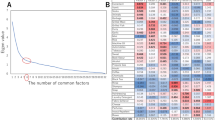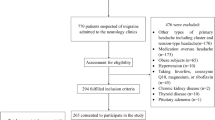Abstract
Background/Objectives
Sulfites are additives commonly used in food and wine industries that are associated to adverse clinical effects such as headaches. The objective of this study is to investigate the possible association between sulfite concentration in wine and the occurrence of headaches in young adults.
Subjects/Methods
Eighty volunteers, aged between 18 and 25 years, were evaluated. Sub-groups (with or without previous headaches related with wine) were created and volunteers were submitted to two wine tests (minimum and maximum sulfite concentration accordingly to weight). A questionnaire was handed out after the test regarding the presence or not of headaches, their main characteristics, as well as other symptoms associated.
Results
Subjects that refer a previous headache history upon wine ingestion presented a risk 2266 greater of developing headaches after wine ingestion with a greater sulfite concentration. Those that refer constant headaches related to wine ingestion previous to the test present a risk of 6232 times more of developing headaches compared to those who refer sporadic headaches related to wine consumption.
Conclusions
In our group of subjects, sulfite concentration in wine is related to the risk of developing headaches in individuals who are susceptible to wine induced headaches.
This is a preview of subscription content, access via your institution
Access options
Subscribe to this journal
Receive 12 print issues and online access
$259.00 per year
only $21.58 per issue
Buy this article
- Purchase on Springer Link
- Instant access to full article PDF
Prices may be subject to local taxes which are calculated during checkout
Similar content being viewed by others
References
Krymchantowski AV, Jevoux CC. Wine and headache. Headache. 2014;54:67–75.
Panconesi A. Alcohol and migraine: trigger factor, consumption, mechanisms: a review. J. Headache Pain. 2008;9:19–27.
Peatfield RC, Glover V, Littlewood JT, Sandler M, Clifford Rose F. The prevalence of diet-induced headache. Cephalalgia. 1984;4:179–83.
Peatfield RC, Fletcher G, Rhodes K, Gardiner IM, de Belleroche J. Pharmacological analysis of red wine-induced migrainous headaches. J Headache Pain. 2003;4:18–23.
Littlewood JT, Gibb C, Glover V, Sandler M, Davies PTG, Clifford Rose F. Red wine as a cause of migraine. Lancet. 1988;1:558–9.
Maxwell CR, Spangenberg RJ, Hoek JB, Silberstein SD, Oshinsky ML. Acetate causes alcohol hangover headache in rats. PLoS ONE. 2010;31:e15963 https://doi.org/10.1371/journal.pone.0015963
Pradalier A, Weinman S, Launay JM, Baron JF, Dry J. Total IgE, specific IgE and prick-tests against foods in common migraine – a prospective study. Cephalalgia. 1983;3:231–4.
Gorman-McAdams M. Sulfites in wine. The myths, the facts, and the truth. 2009. http://www.thekitchn.com/sulfites-in-wine-necessary-or-100878, (Accessed on 28 Dec 2013).
Favero D, Ribeiro C, de Aquino A. Sulfites: Importance in the food industry and possible harm to the population. Food security and nutrition. 2011;18:11–20.
Pozo-Bayon MA, Monagas M, Bartolome B, Moreno-Arribas MV. Wine features related to safety and consumer health: an integrated perspective. Crit Rev Food Sci Nutr. 2012;52:31–54.
World Health Organization, Food and Agriculture Organization of the United Nations. Safety evaluation of certain food additives. Genéve: World Health Organization Press, 2009. http://whqlibdoc.who.int/publications/2009/9789241660600_eng.pdf, (Accessed on 14 Sept 2012).
Jackowetz N, Li E, Mira, de Orduña R. Sulphur Dioxide Content of Wines: the Role of Winemaking and Carbonyl Compounds. Appellation Cornell. 2011;7:1–7.
Chichester CO, Mrak EM, Schweigert BS Advances in Food Research. Orlando: A. Press; 1986. (pgs 2, 7, 22, 31).
Dahl R, Henriksen JM, Harving H. Red wine asthma: a controlled challenge study. J Allergy Clin Immunol. 1986;78:1126–9.
Zaeem Z, Zhou L, Dilli E. Headaches: a Review of the Role of Dietary Factors Curr Neurol Neurosci Rep. 2016;16:101. https://doi.org/10.1007/s11910-016-0702-1
Kelman L. The triggers or precipitants of the acute migraine attack. Cephalalgia. 2007;27:394–402.
Aun MV, Mafra C, Philippi JC, Kalil J, Agondi RC, Motta AA. Additives in food. Brazilian magazine on Alergies and Immunopathology. 2011;34:177–86.
Yang WH, Purchase ECR. Adverse reactions to sulfites. CMAJ. 1985;133:865–80.
Vally H, Thompson PJ. Allergic and asthmatic reactions to alcoholic drinks. Addict Biol. 2003;8:3–11.
Pereira Monteiro JM. Headaches: epidemiological and clinical study of na urban population. Porto: PhD Thesis in Medical Sciences, specialized in Internal Medicine, presented to the Institute of Biomedical Sciences of the Abel Salazar University; 1995.
EUR-Lex Access to the European Union Law. Regulation [CE] n.° 606/2009 of the 10th July 2009 commission which establishes the Regulation of the execution rules of the Council with regards to the categories of wine products, to the oenological practices and restrictions which apply to them [2009]. http://eurlex.europa.eu/LexUriServ/LexUriServ.do?uri=OJ:L:2009:193:0001:0059:pt:PDF (Accessed on 20 Sept 2012).
Kleinbaum, DG Klein, M. Logistic Regression, A Self-Learning Text, 3rd edn. Springer Science + Business Media, 2010.
Hosmer D, Lemeshow S. Applied Logistic Regression, 2nd edn. John Wiley & Sons, 2000.
Headache Classification Committee of the International Headache Society. The international classification of headache disorders, 3rd edn. [beta version]. Cephalalgia. 2013;33:728.
Davis-Martin RE, Polk AN, Smitherman TA. Alcohol Use as a Comorbidity and Precipitant of Primary Headache: Review and Meta-analysis. Curr Pain Headache Rep. 2017;21:42. https://doi.org/10.1007/s11916-017-0642-8
Winter AC, Hoffmann W, Meisinger C, Evers S, Vennemann M, Pfaffenrath V, et al. Association between lifestyle factors and headache. J Headache Pain. 2011;12:147–55. https://doi.org/10.1007/s10194-010-0286-0
Boardman HF, Thomas E, Millson DS, Croft PR. Psychological, sleep, lifestyle, and comorbid associations with headache. Headache. 2005;45:657–69.
Aamodt AH, Stovner LJ, Hagen K, Brathen G, Zwart J. Headache prevalence related to smoking and alcohol use. The Head-HUNT Study. Eur J Neurol. 2006;13:1233–8.
Molarius A, Tegelberg A, Ohrvik J. Socio-economic factors, lifestyle, and headache disorders—a population-based study in Sweden. Headache. 2008;48:1426–37.
Takeshima T, Ishizaki K, Fukuhara Y, Ijiri T, Kusumi M, Wakutani Y, et al. Population-based door-to-door survey of migraine in Japan: the Daisen study. Headache. 2004;44:8–19.
Skypala IJ, Williams M, Reeves L, Meyer R, Venter. C. Sensitivity to food additives, vaso-active amines and salicylates: a review of the evidence. Clin Transl Allergy. 2015;5:34. https://doi.org/10.1186/s13601-015-0078-3.
Wober C, Holzhammer J, Zeitlhofer J, Wessely P, Wober-Bingol C. [2006] Trigger factors of migraine and tension-type headache: experience and knowledge of the patients. J Headache Pain. 2006;7:188–95.
Chabriat H, Danchot J, Michel P, Joire JE, Henry P. Precipitating factors of headache. A prospective study in a national control-matched survey in migraineurs and nonmigraineurs. Headache. 1999;39:335–8.
Funding
This research received no specific grant from any funding agency in the public, commercial, or not-for-profit sectors.
Author information
Authors and Affiliations
Corresponding author
Ethics declarations
Conflict of interest
The authors declare that they have no conflict of interest.
Ethical approval
All procedures performed in studies involving human participants were in accordance with the ethical standards of the institutional and/or national research committee and with the 1964 Helsinki declaration and its later amendments or comparable ethical standards. This project was validated by the Faculty of Health Sciences UBI Ethics Committee, Portugal. All the participants signed an informed consent.
Additional information
Publisher’s note: Springer Nature remains neutral with regard to jurisdictional claims in published maps and institutional affiliations.
Rights and permissions
About this article
Cite this article
Silva, M., Gama, J., Pinto, N. et al. Sulfite concentration and the occurrence of headache in young adults: a prospective study. Eur J Clin Nutr 73, 1316–1322 (2019). https://doi.org/10.1038/s41430-019-0420-2
Received:
Revised:
Accepted:
Published:
Issue Date:
DOI: https://doi.org/10.1038/s41430-019-0420-2
This article is cited by
-
Inhibition of ALDH2 by quercetin glucuronide suggests a new hypothesis to explain red wine headaches
Scientific Reports (2023)
-
Sulfite may disrupt estrogen homeostasis in human via inhibition of steroid arylsulfatase
Environmental Science and Pollution Research (2022)



